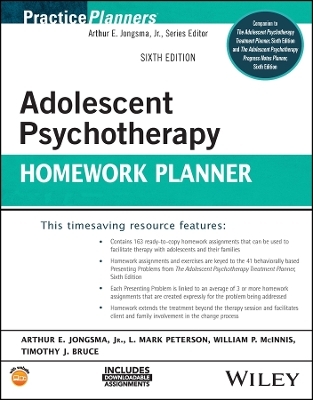
Adolescent Psychotherapy Homework Planner
John Wiley & Sons Inc (Verlag)
978-1-119-98764-2 (ISBN)
In the newly updated sixth edition of The »Adolescent Psychotherapy Homework Planner«, a team of distinguished practitioners delivers a time-saving and hands-on practice tool designed to offer clients valuable homework assignments that will further their treatment goals for a wide variety of presenting problems. The Homework Planner addresses common and less-common disorders—including anxiety, depression, substance use, eating, and panic—allowing the client to work between sessions on issues that are the focus of therapy.
This book provides evidence-based homework assignments that track the psychotherapeutic interventions suggested by the fifth edition of The »Adolescent Psychotherapy Treatment Planner«. They are easily photocopied, and a digital version is provided online for the therapist who would prefer to access them with a word processor. The Homework Planner also offers:
- Cross-referenced lists of suggested presenting problems for which each assignment may be appropriate (beyond its primary designation)
- Several brand-new assignments, as well as adapted assignments that have been shortened or modified to make them more adolescent-client-friendly
- Homework assignments for the parents of adolescents in treatment, assignments for the adolescents themselves, and assignments for parents and adolescents to complete together
An essential and practical tool for therapists and practitioners treating adolescents, The Adolescent Psychotherapy Homework Planner, Sixth Edition will benefit social workers, psychologists, psychiatrists, and other clinicians seeking efficient and effective homework tools for their clients.
ARTHUR E. JONGSMA, Jr., PhD, is Series Editor of the bestselling PracticePlanners®. He has over five decades experience providing mental health services to inpatient and outpatient clients. He has authored or co-authored over fifty books.
L. MARK PETERSON, ACSW, retired Program Manager for Bethany Christian Services Residential Treatment and Family Counseling programs in Grand Rapids, Michigan.
WILLIAM P. McINNIS, PsyD, is a private practitioner with Aspen Psychological Services in Grand Rapids, Michigan. He is co-author of the Adolescent Psychotherapy Treatment Planner.
About the Downloadable Assignments
Wiley PracticePlanners® Series Preface xvii
Acknowledgments xix
Introduction 1
SECTION 1: Academic Underachievement 4
Exercise 1.A Attitudes About Homework 5
Exercise 1.B Break It Down Into Small Steps 11
Exercise 1.C Good Grade/Bad Grade Incident Reports 15
SECTION 2: Adoption 18
Exercise 2.A Beginning a Search for Birth Parents 19
Exercise 2.B Considering a Search for Birth Parents 22
Exercise 2.C My Child’s Search for Birth Parents 26
Exercise 2.D Questions and Concerns Around Being Adopted 29
Exercise 2.E Some Things I’d Like You to Know … 31
SECTION 3: Anger Control Problems 34
Exercise 3.A Anger Checklist 35
Exercise 3.B Anger Control 38
Exercise 3.C Stop Yelling 44
SECTION 4: Anxiety 46
Exercise 4.A Finding and Losing Your Anxiety 47
Exercise 4.B Progressive Muscle Relaxation 50
Exercise 4.C Tools for Anxiety 54
Exercise 4.D What Makes Me Anxious 57
Exercise 4.E Worry Time 61
SECTION 5: Attention-Deficit/Hyperactivity Disorder (ADHD) 63
Exercise 5.A Channel Your Energy in a Positive Direction 64
Exercise 5.B Evaluating Medication Effects 68
Exercise 5.C Getting It Done 73
Exercise 5.D Problem-Solving Exercise 78
Exercise 5.E Social Skills Exercise 82
SECTION 6: Autism Spectrum Disorder 85
Exercise 6.A Managing the Meltdowns 86
Exercise 6.B Moving Toward Independence 89
Exercise 6.C Progress: Past, Present, and Future 92
Exercise 6.D Progress Survey 95
SECTION 7: Bipolar Disorder 98
Exercise 7.A Action Minus Thought Equals Painful Consequences 99
Exercise 7.B Clear Rules, Positive Reinforcement, Appropriate
Consequences 102
Exercise 7.C Medication Resistance 105
Exercise 7.D Mood Disorders Symptom List 108
SECTION 8: Blended Family 110
Exercise 8.A A Few Things About Me 111
Exercise 8.B Assessing the Family—Present and Future 113
Exercise 8.C Interaction as a Family 116
Exercise 8.D Stepparent and Sibling Questionnaire 119
SECTION 9: Bullying/Aggression Perpetrator 110
Exercise #.A Apology Letter for Bullying 111
Exercise #.B Bullying Incident Report 113
Exercise #.C Factors Contributing to Bullying
SECTION 10: Bullying/Aggression Victim 110
Exercise #.A Calm Response to Verbal Bullying 111
Exercise #.B Effective Ways to Manage Cyberbullying 113
Exercise #.C Identify the Impact of Bullying
SECTION 11: Conduct Disorder/Delinquency 122
Exercise 9.A Catch Your Teen Being Responsible 123
Exercise 9.B Headed in the Right Direction 126
Exercise 9.C How My Behavior Hurts Others 130
Exercise 9.D Letter to Absent or Uninvolved Parent 133
Exercise 9.E Patterns of Stealing 136
SECTION 12: Depression-Unipolar 499
Exercise 36.A Bad Thoughts Lead to Depressed Feelings 500
Exercise 36.B Becoming Assertive 504
Exercise 36.C Home, School, and Community Activities I Enjoyed 508
Exercise 36.D Overcoming Helplessness and Hopelessness 512
Exercise 36.E Surface Behavior/Inner Feelings 516
Exercise 36.F Three Ways to Change the World 520
Exercise 36.G Unmet Emotional Needs—Identification and Satisfaction 523
SECTION 13: Divorce Reaction 138
Exercise 10.A Impact of Parents’ Separation/Divorce 139
Exercise 10.B Initial Reaction to Parents’ Separation 142
Exercise 10.C My Thoughts, Feelings, and Beliefs About Divorce 146
Exercise 10.D Stop the Fighting 149
SECTION 14: Eating Disorder 151
Exercise 11.A Body Image 152
Exercise 11.B Fears Beneath the Eating Disorder 155
Exercise 11.C Plan and Eat a Meal 159
Exercise 11.D Reality: Food Intake, Weight, Thoughts,
and Feelings 162
SECTION 15: Gender Dysphoria
Exercise ##.A Exploring Development of Gender Identity ###
Exercise ##.B Current Experience of Gender Identity ###
Exercise ##.C Gender Identity: Future Me ###
SECTION 16: Grief/Loss Unresolved 167
Exercise 12.A Create a Memory Album 168
Exercise 12.B Grief Letter 170
Exercise 12.C Honoring the Anniversary of the Loss 174
Exercise 12.D Memorial Collage 176
Exercise 12.E Moving Closer to Resolution 178
SECTION 17: Intellectual Development Disorder 181
Exercise 13.A Activities of Daily Living Program 182
Exercise 13.B A Sense of Belonging 188
Exercise 13.C Hopes and Dreams for Your Child 192
Exercise 13.D Supportive Services for Your Child 195
SECTION 18: Loneliness
Exercise 14.A What Do I Value?
Exercise 14.B Practice Being Mindful
Exercise 14.C. Fusing And Defusing: What?
SECTION 19: Low Self-Esteem 198
Exercise 14.A Maintaining Your Self-Esteem 199
Exercise 14.B Recognizing Your Abilities, Traits, and Accomplishments 203
Exercise 14.C Three Ways to Change Yourself 207
Exercise 14.D Three Wishes Game 210
SECTION 20: Medical Condition 211
Exercise 15.A Attitudes About Medication or Medical Treatment 212
Exercise 15.B Coping With a Sibling’s Health Problems 215
Exercise 15.C Coping With Your Illness 218
SECTION 21: Negative Peer Influences 220
Exercise 16.A Choice of Friends Survey 221
Exercise 16.B I Want to Be Like … 226
Exercise 16.C Reasons for Negative Peer Group Involvement 229
SECTION 22: Obsessive-Compulsive Disorder (OCD) 231
Exercise 17.A Decreasing What You Save and Collect 232
Exercise 17.B Refocus Attention Away From Obsessions and Compulsions 235
Exercise 17.C Thought Stopping 239
SECTION 23: Opioid Use ###
Exercise ##.A How My Thoughts And Feelings Link ###
Exercise ##.B Am I Ready For A Change?###
Exercise ##.C How Do I Live With Chronic Pain?###
SECTION 24: Oppositional Defiant Disorder 241
Exercise 18.A Changing School Rules 242
Exercise 18.B Cooperative Activity 246
Exercise 18.C Filing a Complaint 249
Exercise 18.D If I Could Run My Family 252
Exercise 18.E Switching From Defense to Offense 255
SECTION 25: Overweight/Obesity 258
Exercise 19.A Developing and Implementing a Healthier Diet 259
Exercise 19.B Increasing My Physical Activity 264
Exercise 19.C My Eating and Exercise Journal 268
SECTION 26: Panic/Agoraphobia 271
Exercise 20.A Panic Attack Rating Form 272
Exercise 20.B Panic Survey 276
SECTION 27: Parenting 278
Exercise 21.A Evaluating the Strength of Your Parenting Team 279
Exercise 21.B One-on-One 282
Exercise 21.C Parenting Report Card 286
Exercise 21.D Parents Understand the Roots of Their Parenting
Methods 289
Exercise 21.E Transitioning from Parenting a Child to Parenting
a Teen 293
SECTION 28: Peer/Sibling Conflict 296
Exercise 22.A Cloning the Perfect Sibling 297
Exercise 22.B How Parents Respond to Sibling Rivalry 300
Exercise 22.C Negotiating a Peace Treaty 303
Exercise 22.D Why I Fight With My Peers 306
SECTION 29: Physical/Emotional Abuse Victim 310
Exercise 23.A Identify the Nature of the Abuse 311
Exercise 23.B Letter of Empowerment 315
Exercise 23.C My Thoughts and Feelings 319
Exercise 23.D Self-Esteem Before, During, and After Abuse 322
Exercise 23.E Take the First Step 325
SECTION 30: Posttraumatic Stress Disorder (PTSD) 330
Exercise 24.A Describe the Trauma and Your Feelings 331
Exercise 24.B Describe Your PTSD Symptoms 335
Exercise 24.C Effects of Chronic or Long-Term Trauma/Stress 338
Exercise 24.D Impact of Frightening or Dangerous Event 341
SECTION 31: Runaway 353
Exercise 26.A Airing Your Grievances 354
Exercise 26.B Another Place to Live 357
Exercise 26.C Describe Life on the Run 360
Exercise 26.D Home by Another Name 363
Exercise 26.E Undercover Assignment 366
SECTION 32: Schizophrenia Spectrum 343
Exercise 25.A Describe Your Hallucinations 344
Exercise 25.B My Irrational Thoughts 347
Exercise 25.C Recognizing Early Warning Signs 350
SECTION 33: School Violence 368
Exercise 27.A Plan and Evaluate a Family Activity 369
Exercise 27.B Reasons for Rage 372
Exercise 27.C School Violence Incident Report 376
SECTION 34: Sexual Abuse Perpetrator 379
Exercise 28.A Celebrity-Style Interview 380
Exercise 28.B Evaluating My Treatment Progress 383
Exercise 28.C Getting Started 387
Exercise 28.D Negative Effects of the Abuse 391
Exercise 28.E Your Feelings and Beyond 395
SECTION 35: Sexual Abuse Victim 399
Exercise 29.A Denial Within the Family 400
Exercise 29.B Letter of Forgiveness 403
Exercise 29.C My Story 407
Exercise 29.D Perpetrator Apology to the Victim 410
Exercise 29.E You Are Not Alone 415
SECTION 36: Sexual Identity Confusion 419
Exercise 30.A Disclosing Homosexual Orientation 420
Exercise 30.B Parents’ Thoughts and Feelings About Son’s/Daughter’s
Sexual Orientation 424
Exercise 30.C Unsure 428
SECTION 37: Sexual Promiscuity 431
Exercise 31.A Connecting Sexual Behavior With Needs 432
Exercise 31.B Looking Closer at My Sexual Behavior 436
Exercise 31.C Pros and Cons of Having Sex 439
SECTION 38: Sleep Disturbance ###
Exercise ##.A Sleep Assessment ###
Exercise ##.B My Plan For Better Sleep###
Exercise ##.C Maintaining My Therapeutic Gains###
SECTION 39: Social Anxiety 441
Exercise 32.A Developing Conversational Skills 442
Exercise 32.B Greeting Peers 445
Exercise 32.C Observe Positive Social Behaviors 448
Exercise 32.D Show Your Strengths 452
SECTION 40: Specific Phobia 454
Exercise 33.A Finding a Strategy to Minimize My Fear 455
Exercise 33.B Gradual Exposure to Fear 458
Exercise 33.C School Fear Reduction 462
SECTION 41: Substance Use 465
Exercise 34.A Keeping Straight 466
Exercise 34.B Saying Goodbye to My Drug 469
Exercise 34.C Taking Your First Step 472
Exercise 34.D The Many Changes Necessary for Recovery 477
Exercise 34.E Welcome to Recovery 480
SECTION 42: Suicidal Ideation 483
Exercise 35.A No Self-Harm Contract 484
Exercise 35.B Painful Effects of Suicide 489
Exercise 35.C Past and Present Hurt—Hope for the Future 493
Exercise 35.D Symbols of Self-Worth 497
APPENDIX A: Alternate Assignments for Presenting Problems 525
APPENDIX B: Alphabetical Index of Exercises 541
TIMOTHY J. BRUCE, PhD, is Professor Emeritus in the Department of Psychiatry and Behavioral Medicine at the University of Illinois College of Medicine.
| Erscheinungsdatum | 28.02.2024 |
|---|---|
| Reihe/Serie | PracticePlanners |
| Verlagsort | New York |
| Sprache | englisch |
| Gewicht | 1202 g |
| Einbandart | kartoniert |
| Themenwelt | Geisteswissenschaften ► Psychologie ► Klinische Psychologie |
| Sozialwissenschaften ► Pädagogik | |
| ISBN-10 | 1-119-98764-4 / 1119987644 |
| ISBN-13 | 978-1-119-98764-2 / 9781119987642 |
| Zustand | Neuware |
| Haben Sie eine Frage zum Produkt? |
aus dem Bereich


